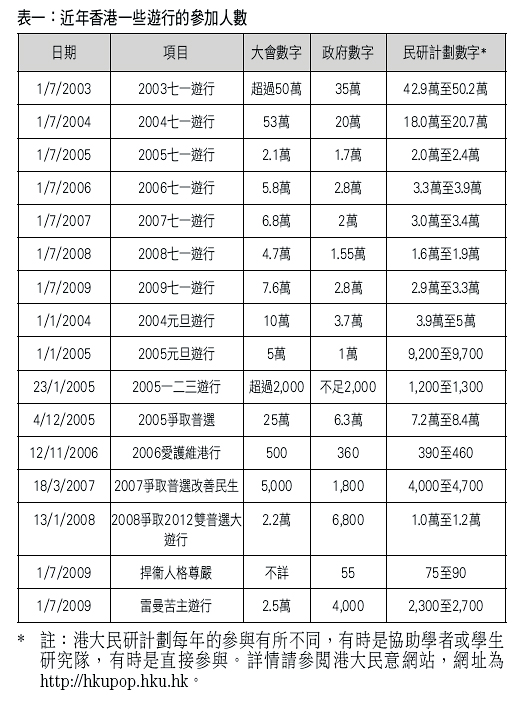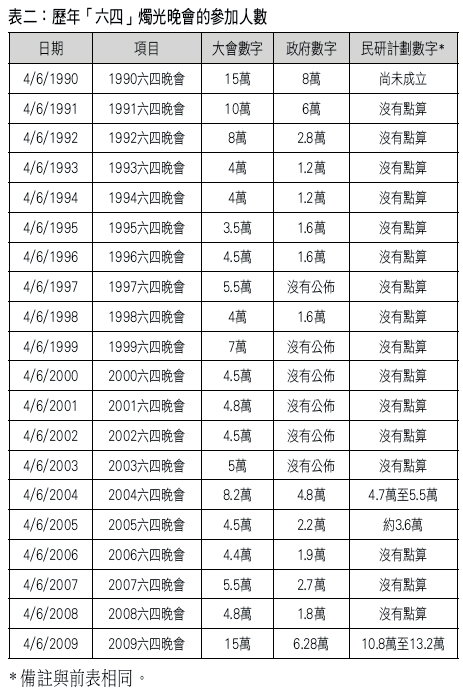The Hong Kong 7/1 March: Media Coverage
Here are the Hong Kong newspaper front page stories (for those newspapers that have online editions with front pages shown):
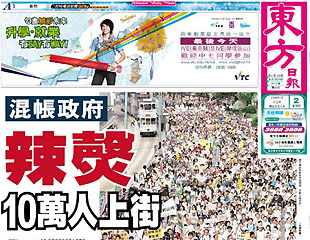
Oriental Daily:
Lousy government
Bitter voices
100,000 people in the streets
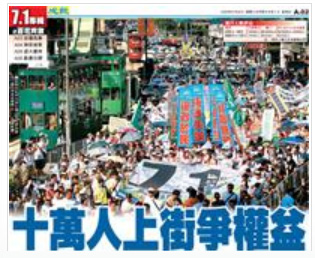
Sing Pao:
100,000 strive for their rights and interests in the streets
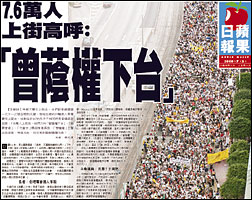
Apple Daily:
76,000 in the streets calling out loud:
"Down with Donald Tsang"
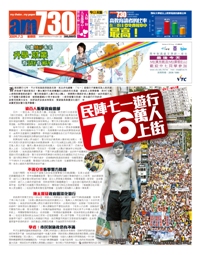
am730:
Civil Human Rights Front July 1 March
76,000 persons in the streets
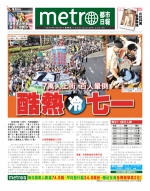
Metro:
Extreme heat cools down July 1
70,000 people in the streets
100 persons faint
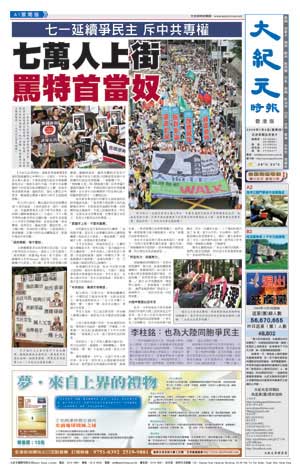
Epoch Times:
70,000 people in the streets
Curse Chief Executive Donald (homonym with "Slave")
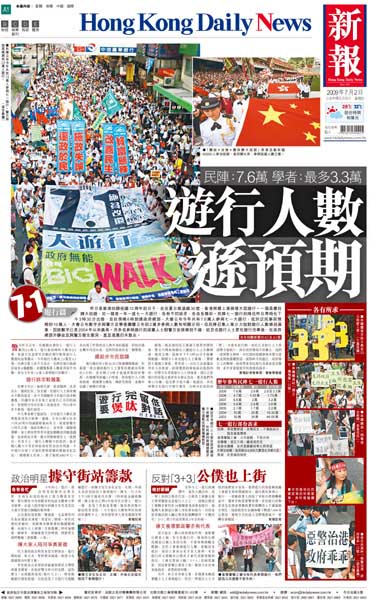
Hong Kong Daily News:
Number of marchers fewer than expected
Civil Human Rights Front: 76,000; scholars: at most 33,000
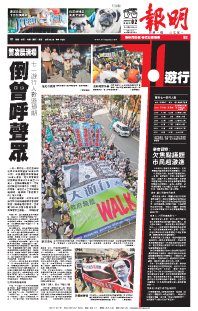
Ming Pao:
July 1 march
Many anti-Tsang voices
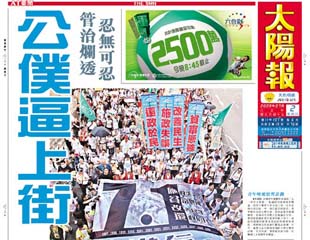
The Sun:
Rotten governance not longer tolerable
Public servants forced into the streets
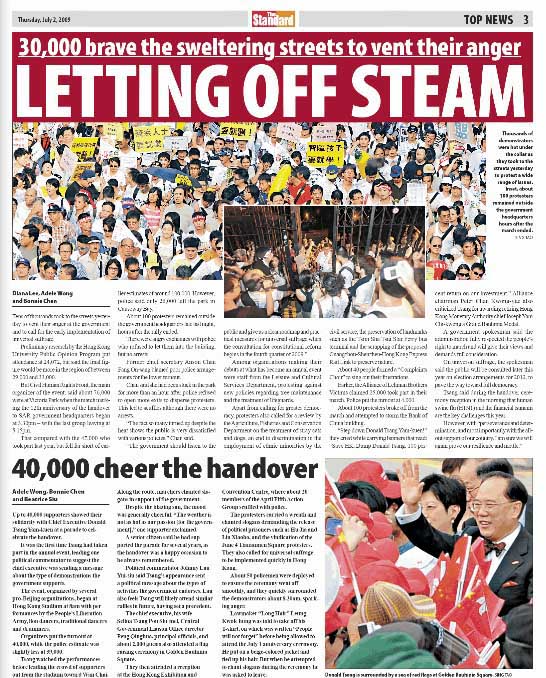
The Standard:
30,000 brave the sweltering streets to vent their anger: Letting off Steam
40,000 cheer the handover
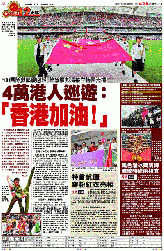
Wen Wei Po:
40,000 Hong Kong people parade:
"Go, Hong Kong!"
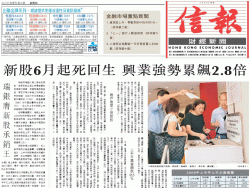
Hong Kong Economic Journal:
New shares revive in June
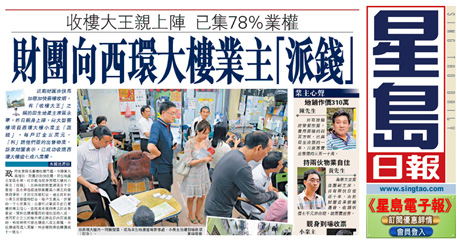
Sing Tao:
Financial group hands out money to owners in Sai Wan building
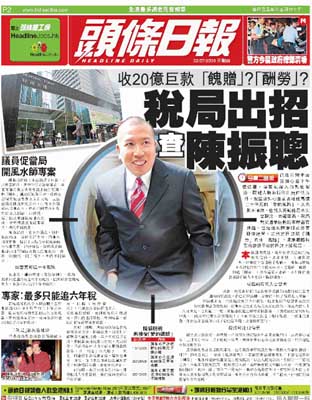
Headline News:
Inland Revenues Departments figures way out
to investigateTony Chan
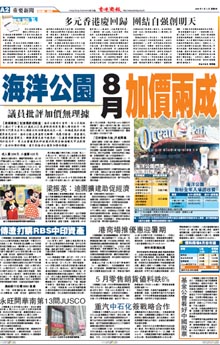
Hong Kong Commercial Daily:
Ocean Park increases admission price by 20% in August
Estimates of the Number of Marchers
(Ming Pao)
As for the number of marchers, the Civil Human Rights Front estimated 76,000 persons. The Hong Kong University Public Opinion Programme estimates between 29,000 and 33,000 persons. Hong Kong University Social Work and Social Administration Department professor Paul Yip Siu-fai and Social Statistics Professor John Shone estimated 28,000 persons. The police estimated that the peak number was 28,000.
Many marchers aimed right at Chief Executive Donald Tsang. There were banners that read:
- Donald Tsang, professional shoeshine boy 曾蔭權職業擦鞋仔
- Donald Tsang pretending to be our representative 曾蔭權扮代表
and shouted slogans such as:
- Donald Tsang, spare us your efforts 曾蔭權慳D
- Donald Tsang PK (literally, trip down on the street) 曾蔭權仆街
- Donald Tsang, eat a banana 曾蔭權食蕉
In recent years, the SAR government has repeated made mistakes in governance and popular discontent is brimming over. Yesterday more than 100,000 citizens braved the 32 degree heat and expressed their dissatisfaction in the streets. This is the largest number of people who have demonstrated on July 1 ever since the Donald Tsang administration came in. The numbers included 25,000 marchers claimed by the Lehman Brothers victims and 76,000 marchers claimed by the Civil Human Rights Front. Although the marches had different demands, they all directed their aim at Donald Tsang and his SAR government officials. Many banners and slogans were present, including "Down with Donald Tsang."
Every since 2003, the Civil Human Rights Front has organized a march on July 1. Yesterday, the newly formed Lehman Brothers victims led off with a different march. The organizers estimated that 25,000 victims and their families marched yesterday. The police estimated that only 40,000 started out from Victoria Park. The Hong Kong University Public Opinion Programme estimated that there was a maximum of 2,700 persons.
Next, the Civil Human Rights Front began march with the themes of: "Mistakes in governance, inequality of wealth, improve people's livelihood, return politics to the people." The Civil Human Rights Front claimed that there were 76,000 participants, which is the highest figure since 2004. The police said that 26,000 persons departed from Victoria Park and the peak number was only 28,000. Hong Kong University counted at most 33,000 persons.
Before either the march by the Lehman Brothers victims and the Civil Human Rights Front, about 50 netizens marched first to protest against the pan-democrats. Each marcher carried a sign that said "Pan-democrats does not equal me" and held banners such as "Obscene language at the Legislative Council, Legislative Councilors have poor conduct," "False democracy, real dictatorship," "Objecting to everything, looking for trouble," "Protest populist violence, boycott pan-democratic dictatorship" and so on.
(SCMP)
The political divisions in Hong Kong were as stark as ever yesterday as the chief executive launched a parade by tens of thousands of Beijing loyalists from the Hong Kong Stadium and a similar number of anti-government protesters joined the annual march from Victoria Park. Although fewer protesters turned out than organisers had expected, it was still the biggest show of discontent since Donald Tsang Yam-kuen succeeded Tung Chee-hwa at the head of the government in 2005.
Protesters expressed diverse demands, ranging from the early introduction of universal suffrage to alleviating poverty, protecting animal rights and introducing a minimum wage for all. Mr Tsang came under fire from many protesters, with some urging him to step down.
In contrast, Beijing loyalists watched a handover celebration in So Kon Po, and afterwards more than 40,000 paraded to Southorn Stadium in Wan Chai accompanied by music, dragon dancers and children in opera costumes. "It is time for celebration, not a time for discontent," said Ko Po-chun, 49, after watching performances by singers and People's Liberation Army soldiers.
The Civil Human Rights Front, organiser of the annual protest, estimated 76,000 took part in its three-and-a-half hour rally and march to vent their dissatisfaction with the government. A police spokesman said there had been about 28,000 people at the height of the rally, while the University of Hong Kong's public opinion programme put the turnout at between 29,000 and 33,000. Paul Yip Siu-fai, professor of social administration at the university, gave a preliminary estimate, based on video and on-site polls, of 28,000.
The front had predicted 100,000 would join the march from Causeway Bay to Central. Last year the front said 47,000 marched.
(Sing Tao)
The July 1 march organized by the Civil Human Rights Front set off from Victoria Park at 3:30pm. The parade was led by young people and grass roots people. Thirty-four different participating organizations expressed different demands. The last marchers departed from Victoria Part at 4:50pm. The head of the parade reached Government Headquarters in Central at 6pm while the end of the parade got there at 8pm. Most people dispersed after reaching Government Headquarters but some people refused to leave.
The Civil Human Rights Front announced the number of marchers to be 76,000. But the police, the Hong Kong University Public Opinion Programme and the Hong Kong University Social Work and Social Administrator professor Paul Yip Siu-fai and Hong Kong University Social Sciences Research Centre director John Shone came up with estimates between 26,000 and 33,000.
Paul Yip Siu-fai explained that he and John Shone set up two counting stations in Causeway Bay and Admiralty which recorded 22,000 and 27,000 persons. At the second station, they also interviewed 511 marchers of whom 406 also passed through the Causeway Bay counting station. Therefore, they estimated that the number of marchers to be about 28,000 plus or minus 2,000.
Hong Kong citizens used the July 1 march to express various demands. This is one way for the SAR government to gauge public opinon. But the opposite camp tried to "hijack" the participants for their own political chips. On one hand, they tried everything possible to boost attendance. On the other hand, they fall into "the mystery of the numbers" by inflating the numbers in order to increase their momentum.
Yesterday, the number of marchers was revealed. The Hong Kong police said that 26,000 persons departed from Victoria Park. The Civil Human Rights Front insisted that there were 76,000 persons, which was the highest figure since 2004. But the Chinese University of Hong Kong and Hong Kong University joint project counted between 29,000 and 33,000 persons, which is quite close of the police figure and far fewer than the 76,000 publicized by the Civil Human Rights Front. Once again, this exposed the trick of "inflating the numbers" by the Civil Human Rights Front.
Persons in politics point out that the Hong Kong economy is under a cloud due to the A/H1N1 virus and the international financial crisis, and there is quite a bit of social discontent due to the high unemployment rate. The opposition thinks that there is an opportunity to leverage the social discontent. Therefore, they used their propaganda machines to mobilize citizens to march, hoping that a big number would be useful as bargaining chip. Earlier, the Civil Human Rights Front predicted that 150,000 persons will attend. The Democratic Party chairman Albert Ho even predicted 200,000 persons. But the plans of the opposition fell short and the number of marchers was clearly less than their predictions. So once again, they had to resort to the old trick of "number inflation."
For many years, the opposition has played with the numbers. They only treat the demands and wishes of the citizens as "a numbers game" and "a political show." Ultimately, they ignore and insult the demands and wisdom of the citizens.
Apple Daily interviewed 200 marchers
How many times have you participated in July 1 marches over the years?
1 time: 25.5%
2 times: 15%
3 times: 14.5%
4 times: 11%
5 times: 5.5%
6 times: 8%
7 times: 20.5%Reason why you marched?
Strive for double universal suffrage: 57.5%
Dissatisfaction with government mistakes by Donald Tsang: 23.5%
Protest the government's failure to save the economy: 9%
Demand the release of Liu Xiaobo: 5%
Other reasons: 5%Do you want to see the functional constituency eliminated from the Legislative Council?
Yes: 84.5%
No: 6.5%
Don't know/no opinion: 9%How should the threshold for candidacy in the Chief Execution election be set?
Low - anyone with any political position should be able to enter: 89.5%
High - only those acceptable to the Central Government should be able to enter: 2%
Don't know/no opinion: 8.5%
(Hong Kong University Public Opinion Programme)
Enumerators were posted on the pedestrian overpass at the intersection of Hennessey Road and Arsenal Street. They counted the number of persons who walked underneath the bridge in the three traffic lanes on the road. Here are the number of marchers by time of day.
17:00-17:19: 275, 243, 21
17:20-17:39: 1931, 2099, 1353
17:40-17:58: 1281, 1427, 829
18:00-18:19: 1564, 1869, 1120
18:20-18:39: 1249, 1463, 949
18:40-18:59: 1053, 1783, 745
19:00-19:19: 699, 1119, 749
19:20-19:39: 117, 76, 56
Total: 8938,11001, 6155The total number of enumerated is 8938 + 11001 +6155 = 26094.
A number of persons might have left the procession before the enumeration location, and a number of persons might have joined the procession after the enumeration location. In previous years, HKU POP has conducted telephone interviews to obtain an estimate of an adjustment factor to the raw enumerated count. If the 2008 adjustment factor of 1.28, then the estimated number of marchers today is 26094 x 1.28 = 31,000 (rounded).
Historical Estimates
2003: 462,000
2004: 193,000
2005: 22,000
2006: 36,000
2007: 32,000
2008: 17,000
2009: 31,000
(Hong Kong Economic Journal) Editorial
At every march or assembly, there is always a discrepancy between the numbers claimed by the organizers and the police. At the July 1 march yesterday, the Civil Human Rights Front organizers announced that 76,000 persons marched, whereas the police said that the peak figure was 28,000 persons. The difference is almost three times! The scholars calculate about 30,000 persons which is close to the police figure. The number of marchers has been a political issue. Since 2003, the pro-China camp has repeatedly accused the democratic organizations of exaggerating numbers and magnifying the number of people in the street in order to prove that the SAR government has lost the hearts and mind of the people who express their discontent by marching in the streets. This is then extrapolated to the fact that the people could only go into the streets because there is no universal suffrage in Hong Kong! For the pro-China camp, the exaggeration of the number of marchers is a way to smearing the SAR government and destroying stability and prosperity. For the pro-democracy camp, a large number of marchers is the only way for the people of Hong Kong to demand universal suffrage, because only large numbers will make the SAR and Beijing governments take their demands seriously.
Several renowned scholars at local universities have contributed significantly towards solving the "mystery" of how to count the number of marchers. They searched the literature and they conducted personal observations from which they made certain important discoveries. Their material will be eventually published in this newspaper, so the interested readers should pay attention.
Hong Kong Democratic Party chairman Albert Ho said beforehand that 200,000 persons will march in the streets on July 1. The other pan-democratic convenors said in the press conference that they estimated about 100,000 persons will march, which is a large-scale downward revision. Perhaps they knew what was going to happen in that fewer people will be coming. Even after the revision, their announced 76,000 is much lower than their predicted 100,000 and it is also a long way from the 30,000 estimated by the scholars. So what caused the number of marchers to decrease so significantly? Yesterday, many scholars said after the fact that the government has managed to put out many fires (including successfully persuading the police from demonstrating themselves). But these scholars seemed to have forgotten that prior to July 1, they had accused the government of incompetence in governance and lacking in trustworthiness ... According to their views, there should be a huge demonstration yesterday. In recent years, the Hong Kong scholars have been more interested in criticism rather than analysis of politics in Hong Kong. Yesterday many of those post facto comments were not helpful for citizens who wish to understand the current situation.
(SCMP) Pan-democrats to review what went wrong By Ambrose Leung. July 3, 2009
The pan-democratic camp will today review what went wrong at the July 1 march after the turnout fell short of expectations, amid the realisation that the march is becoming a platform for radical protesters, who may deter more moderate marchers.
Organiser and unionist legislator Lee Cheuk-yan admitted that initial hopes for a turnout of 100,000 marchers had been too ambitious. "We originally expected that the same crowd that turned up for the June 4 vigil would come," Mr Lee said ahead of today's soul-searching meeting to review Wednesday's operation. But one thing was clear among the various demands aired by the marchers - that all were unhappy with the government."
Organisers estimated that 76,000 turned up to show their anger, while the University of Hong Kong public opinion programme put it at 29,000 to 33,000, and police said 28,000. More than 150,000 joined the June 4 candle-light vigil to mark the 20th anniversary of the Tiananmen Square crackdown in Beijing, raising hopes of a similar turnout for Wednesday's march on the 12th anniversary of the handover.
Democrat Cheung Man-kwong said pan-democrats should learn to accept that, since the July 1 protest had become a platform for different groups to air their demands, the turnout would fluctuate from year to year. One marked difference at this year's protest from previous years were the radical slogans shouted by many protesters, among them the growing number of disgruntled young people led by the League of Social Democrats, who directed abuse directly at Chief Executive Donald Tsang Yam-kuen. Mr Cheung said: "It might have deterred some school teachers and youngsters from joining because they do not like swearing."
When asked whether such tactics could discourage the participation of the middle class, Civic Party leader Audrey Eu Yuet-mee said democracy meant diversity, and people were free to choose their own way to express their demands. "What we all marched for yesterday was a fair and equal political system and good governance," she said.
Democrat Lee Wing-tat denied the turnout meant the protest was a failure, but admitted it was a time to review strategy. "The lack of a focused single issue to drive people mad was perhaps the reason not as many as expected turned up," he said. "Universal suffrage has been put on the backburner by the government until the year end, and people are adopting a wait-and-see attitude."
Jackie Hung Ling-yu, vice-convenor of the Civil Human Rights Front which organised the march, was unhappy that several political groups conducted fund-raising activities along the protest's route, which she said slowed down the march from Victoria Park to Central. Some activists also said the unplanned sit-in held by some protesters at the Central Government Offices after the march, resulting in their removal by police, might have tarnished the march's image.
Chief Secretary Henry Tang Ying-yen yesterday said the government would "listen humbly" to the demands aired by the protesters.
(Hong Kong Economic Times) July 3, 2009.
民陣召集人韋少力昨指,遊行人數最多的路段,是介乎銅鑼灣至灣仔,而昨日天氣炎熱,不少人中途加入,亦有不少市民在中途離隊,她質疑警方與學術機構的統計,未有包括有關市民。
韋又強調,民陣在遊行途經的街道,分別設立6個點算站,銅鑼灣和灣仔各設兩個,中環和金鐘各1個,工作人員將遊行的每行橫排人數,乘以行數,同時亦會計算遊行隊伍旁的街站人數,最後再取平均數,得出7.6萬的遊行人數。Civil Human Rights Front convenor Wai Siu-lik pointed out that the number of marchers were highest between Causeway Bay and Wanchai. It was hot yesterday, so that many people joined during the procession while many others left before the finish. She questioned whether the police and the academic organizations included these citizens.
Wai also emphasized that the Civil Human Rights Front set up six counting stations (two each in Causeway Bay and Wanchai, one each in Central and Admiralty). The workers counted the number of marchers in each lane, multiplied by the number of lanes and at the same time counted the number of people who stood in the sidewalk next to the marchers. Finally, they took the average and obtained the figure of 76,000.
如何統計大型遊行集會的人數 蘇鑰機 鍾庭耀,傳媒透視
